2. Observing ECEC practices at the Akita University-affiliated kindergarten: mimamoru and uketomeru approaches
(1) Kindergarten attached to the Faculty of Education and Human Studies at Akita University and their ECEC practices
Like many other national university-affiliated kindergartens, this kindergarten also aims to achieve the primary goal of early childhood education, that is, "children's voluntary play within peer groups" specified by the Courses of Study for Kindergartens. The kindergarten promotes children's development by focusing on their autonomy, understanding their thoughts and behavior patterns in play, and enhancing the environment where they can learn effectively through play.
Most childcare facilities for preschoolers operate relatively long hours, including daycare service hours. However, the Akita University-affiliated kindergarten provides childcare services for only four hours per day. Within such a short time, the kindergarten is committed to ECEC appropriate for the developmental process of young children.
Currently, the kindergarten has four classes in total; two for children aged three, one for those aged four, and one for those aged five. Each class has one supervising teacher and one assistant teacher. These teachers are designated through personnel exchanges with the prefectural government. Most are elementary/special-needs school teachers holding kindergarten teaching certificates and have been allocated to the kindergarten as kindergarten teachers for the first time. Therefore, they often face new situations and feel somewhat lost at the outset. For example, most teachers basically teach collectively at elementary/special-needs schools. Of course, classes are determined based on each child's progress, but the teaching style seems to be somewhat different from ECEC.
(2) Y's behavior in the four-year-old class and his teachers
Between June and November 2021, the primary author of this article conducted six observational studies on Y and other children in the four-year-old class of the Akita University-affiliated kindergarten. As explained above, teachers are assigned through personnel exchange with the prefectural government. Teacher Konno was a teacher of special-needs education and was assigned to be a supervising teacher to the four-year-old class of the Akita University-affiliated kindergarten in the previous year. Teacher Ono is an assistant teacher, working for five years at the kindergarten, with eleven years of teaching experience.
In this section, I will explain (a) Y's behavior and e-mails with his teachers and (b) the support of teachers by embracing children's feelings and behavior, which is beyond the practice of "watching children without intervention" through interviews with them.
(a)Y's behavior: from his teachers' comments and observation records
This article will discuss the support of teachers by embracing children's feelings and behavior based on the interactions between Y, a boy in the four-year-old class, and his teachers. First, I will explain how Supervising Teacher Konno and Assistant Teacher Ono are involved with Y.
The following statements describe Y's behavior and Teacher Konno's involvement with Y since she was allocated to the four-year-old class.
Y is a very active boy and likes playing through physical activities. Always being straightforward, he can also work passionately on what interests him, with great enthusiasm. When Y moved up to the four-year-old class, he looked very nervous since he had to attend a new class with two new teachers (us) in a new nursery room. Every day, he came to the kindergarten with a strained expression. He avoided making eye contact and talked to us using honorific expressions, looking shy. On the other hand, he would come on to his ex-classmate saying, "You arrived later than me today!" When he had difficulties changing his clothes, he cried, "I hate it! I don't want to do anything!" He often had troubles with his peers, even hitting them on occasion. He often let his emotions get the best of him while playing battles. We often desperately tried to stop him from running off like a loose cannon. If we tried to hug him when he lost a fight with his peers and broke into a flood of tears, he would always reject us, shouting, "No! Let me go!" At that time, Y's body was tense and stiffened whenever we touched him.
First, we tried to talk to and listen to Y as often as possible so that he would gradually understand that we liked him and that he was safe to do anything he wanted to. He always rejected us when we tried to hold him in our arms, saying, "No! Let me go!" As he did not show symptoms of tactile hypersensitivity, we thought he was not accustomed to physical contact with people apart from his family in his kindergarten life. Therefore, we tried to hold hands with him on various occasions and gently touch his body when we talked. In this way, we expected him to get used to physical contact with others and feel relaxed with us.
One day, when I found Y crying bitterly after quarreling with his peer, I came up to him and held him around the shoulders. This time, he did not reject me. Instead, he gradually leaned on me and continued crying until he calmed down. Y still fought with his peers and cried hard almost every day, but he gradually became accustomed to physical contact with us, allowing us to hug him. When I took him in my arms, I felt his tension gradually easing from his anger and frustration, comfortably leaning on us. His reaction made us happy. After he calmed down and stopped crying, we gently told him, "We understand how you feel, but you over-did it." Then Y would nod obediently. After we had a small talk about the weather or about other peers playing, Y cheered up and went back to play. After that, when he saw us talking to the child who quarreled with Y, he seemed to care about what was going on and came over to us, then even watched how that child was and casually talked to him. He obviously had feelings for his friend. Whenever Y quarreled with his friends, we tried to stay with him, holding him in our arms until he could get his feelings straight and went back to play.
The comments from teachers indicate that they are appropriately involved with Y, who shows his emotional movements freely and cries bitterly after a quarrel. The support of teachers with the "all-embracing" approach works well, as Y gets used to staying with teachers, feeling relaxed and comfortable.
Next, I will discuss the support of teachers with the "all-embracing" approach based on the results of my observation of the interactions between Y and his teachers at the Akita University-affiliated kindergarten. After six observational studies, I confirmed that the support of teachers with the "all-embracing" approach is most apparent when they take care of the child after a quarrel until the child calmed down.
Photo 1 shows Y playing on a climbing frame with four peers in late June. Photo 2 shows Y quarreling with one of them, and as a result, three peers left him alone. Assistant teacher Ono was smoothing over Y's back for a while. Photo 3 was taken when children in the five-year-old class visited the four-year-old class in mid-July. Y boldly fought with older boys but lost the fight. Photo 4 shows Y crying bitterly after losing. Photo 5 shows Supervising Teacher Konno, who watched the children's quarrel from some distance and hugged Y in her arms after he lost the quarrel.
Teacher Konno also commented that she stayed with Y holding him in her arms until he calmed down and went back to play. When I observed them, it was apparent that teachers always stayed with him physically and mentally by embracing his feelings and behavior.According to previous studies, it is pointed out that Japanese ECEC teachers do not talk too much to a child who feels stressed; instead they have modest physical contact with the child (Burke & Duncan, 2014). When observing children playing at the Akita University-affiliated kindergarten, teachers provided appropriate support for children who were stressed or upset after quarreling with peers by actively maintaining physical contact with them. For example, teachers stroke or caress children's backs, or hold them tightly when crying bitterly. In this way, they embrace children's feelings and behavior instead of just touching them. The characteristic of ECEC in Japan is embracing children's feelings and thoughts without separating anyone from the group.
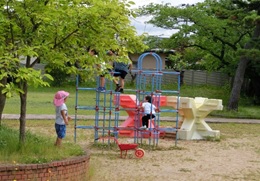 |
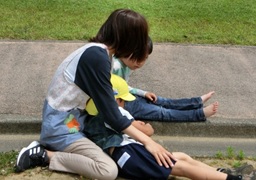 |
|
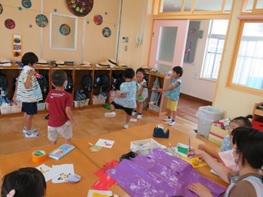 |
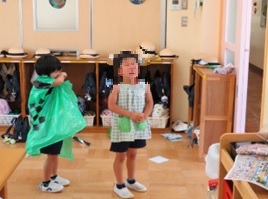 |
|
| Photo 3: Y fighting with older boys | Photo 4: Y crying after losing the fight | |
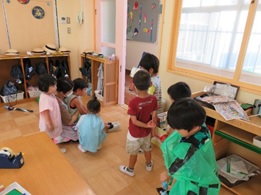 |
||
| Photo 5: Y hugged by his teacher |
(b)Comments from teachers
Next, I will discuss the support of teachers by embracing children's feelings and behavior patterns, which is beyond the practice of the mimamori approach based on my e-mail communications with Teacher Konno. I sent my comment to her by e-mail after I observed children at the kindergarten for the day and received her reply. The following statements are excerpts from our communications about Y (Table 1). In Table 1, the expressions that suggest the practices of mimamoru and the uketomeru approach are underlined.
| June 9 | Y actively spends time in the kindergarten through various daily physical and mental experiences. He gradually seems to have gotten used to the environment surrounding him and feels relaxed [...] I will continue watching the children warmly. |
| July 8 | Y still maintains a harsh attitude toward other children. He often says, "You're weird" or "You're so slow" to his peers. These behavior patterns are the result of his experiences over the years, so we will gradually try to untangle his knots. For example, he doesn't say "I hate you!" to us anymore when he is scolded by us (Teachers Konno and Ono). Instead, he has learned to control his feelings and say, "Ummmm... I won't play with you for a while!" Isn't he so cute! |
| July 16 | When Y was crying after fighting with older boys from the five-year-old class, Teacher Konno asked H standing nearby to "Take care of Y." Then, H rushed into the five-year-old class and stood up for Y saying, "Hey! If you do that again, we won't play with you anymore!" [...]Three days to go before the summer vacations. Until then, I hope to interact with the children as much as possible. |
| October 7 | Y has grown out of his old self after the Sports Day. He participated in a foot race where fast runner boys competed. On the rehearsal day, he immediately tripped over and started crying bitterly. His peers suggested rehearsing again for Y, but Y said, "I won't take part on Sports Day anymore." After that, he did not join rehearsals at all. Nevertheless, he took part in the race on Sports Day, and he looked really happy that he enjoyed the Sports Day with his peers (although he did not finish first). After that, he seemed to feel more affection toward his peers. He shows a more friendly attitude toward his peers and teachers. Now, he is willing to help others and often says "Thank you" or "You're kind." Today, I talked to the children about some sweet potatoes that the older-class children had grown and harvested. Y understands this story very well now. I will continue overseeing children and understand the development progress of each child. |
As one of the characteristics of the developmental process for four-year-old children, "ripples of emotion" are said to emerge within children through various experiences and interactions with people and things (Kishi, 2008). Teachers' comments about Y imply that they are well prepared to watch over children's flickering emotions through the mimamoru approach and support them by embracing their feelings and behavior (uketomeru).
(To be continued in Part 3)
References:
- Burke, S., Duncan, J.(2014). Bodies as Sites of Cultural Reflection in Early Childhood Education. New York. Routledge.
- Chinatsu Kishi. (2008). Theory of Education and Childcare Curriculums. Chapter 4: Four-Year-Old Children at Kindergarten. Takako Kawabe (ed.). Tokyo Shoseki Co., Ltd.
| | 1 | 2 | 3 | |
Naoko Konno (Teacher at a kindergarten attached to the Faculty of Education and Human Studies, Akita University)
Mitsuyo Ono (Teacher at a kindergarten attached to the Faculty of Education and Human Studies, Akita University)
Yuko Yamana (Professor in charge of the “Combined Courses for Child Development and Special Needs Education,” Faculty of Education and Human Studies at Akita University)
- [Temperamental Children Documented in Preschool Field Notes] Part 5: Encounter with Otherness - Cross-Age Interactions and Conflicts
- [China, USA] Studies in Preschool Education: Communication Conflicts and Management in American and Chinese Children
- [USA] Conflict and Cooperation during Early Childhood
- [Japan] Identifying Factor Structures and Determinants Involved in the Development of "Non" Cognitive Skills in Early Childhood
- [South Korea] Current Situation and Issues of Inclusive Education for Preschool Children in South Korea - II
- A Useful Comparison Table for Improving the Quality of ECEC--International Comparative Study on Free Preschool Education and Childcare (74th OMEP World Assembly and Conference)














